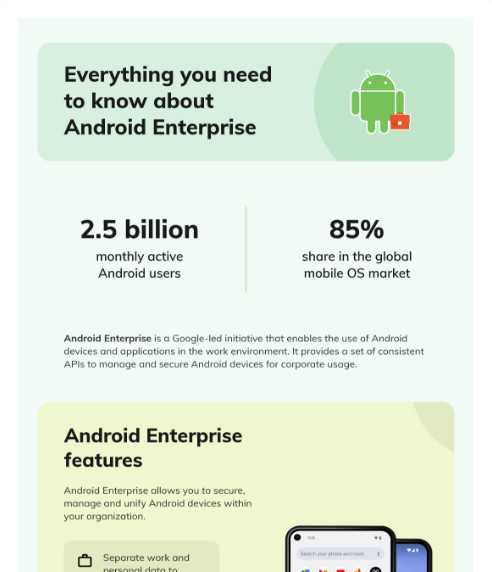Compliance automation: Why is it a critical part of your business?
Learn why automating compliance isn't optional anymore and how it helps you stay audit-ready and secure at scale.

Get fresh insights, pro tips, and thought starters–only the best of posts for you.
Aurelia Clark
Aug 6, 2025
6 min read

With BYOD and personal device use growing across most organizations, ensuring secure access to corporate apps and data is more challenging than ever.
Relying on a one-time device check during enrollment is no longer enough. Devices can drift out of compliance over time missing updates, disabling protections, or falling behind on security patches. Without visibility into the current state of a device, businesses risk exposing sensitive data.
Device Trust from Android Enterprise solves this by enabling continuous, real-time verification of device posture. It helps organizations ensure that every device accessing business resources, whether corporate-owned or personal – meets security expectations at the moment of access.
Device Trust is a new capability in Android Enterprise that enables continuous verification of a device’s security posture. Instead of relying on static checks at enrollment, Device Trust evaluates key security signals from Android devices in real time, helping IT teams enforce up-to-date access policies.
Importantly, Device Trust works across both managed and unmanaged Android devices. This makes it a strong fit for today’s hybrid environments, where employees often use personal (BYOD) devices alongside corporate-owned endpoints. Whether fully enrolled or not, Android devices can now surface trust signals* to the UEM platform, providing broader visibility and stronger security for all endpoints.

Get a quick, visual breakdown of the Android Enterprise program - management options, key benefits, and how it fits into your UEM strategy.
Download InfographicDevice Trust uses Android Management API (AMAPI) – the modern framework for Android Enterprise management.
It surfaces over 20 key security signals directly from Android devices and feeds them into the UEM platform. Because these signals come directly from Android via AMAPI, there’s no need for UEM solutions to build or maintain custom agents. The data flows natively into the platform for use in policy enforcement. With Hexnode, this process is seamless, Device Trust signals become part of your normal device management and compliance workflows, with no extra complexity.
Device Trust checks a wide range of indicators to verify a device’s security posture in real time. Some of the most important signals include:
These signals allow IT teams to spot outdated, non-compliant, or potentially risky devices and automatically adjust access policies as needed.
One of the biggest advantages of Device Trust is its flexibility. Posture checks aren’t limited to fully managed devices they can also be extended to unmanaged and BYOD endpoints.
In other words, personal devices can surface trust signals without needing full EMM enrollment, giving IT better visibility across mixed-use environments, without disrupting user privacy.
With Device Trust, Hexnode brings real-time device posture into everyday policy workflows. As security signals update, Hexnode can dynamically enforce access policies, keeping controls in step with each device’s current state.
This makes it easier to support Zero Trust* security models, where access decisions are based not just on user identity, but also on whether the device is secure right now.
It also simplifies security across BYOD and mixed device environments. Whether the device is corporate-owned or employee-owned (and enrolled), Device Trust gives IT clear, live visibility, making it easier to maintain consistent security without slowing users down.
With Device Trust, Hexnode gives you a clear, consistent view across your entire fleet of managed Android devices, whether corporate-owned or BYOD (enrolled through Android Enterprise). Devices continuously surface live security signals, helping IT teams enforce the right policies at all times.
Bringing in contractors or short-term staff? With Android Enterprise enrollment and Device Trust, devices can be verified quickly, allowing secure access without complex setup.
Real-time posture signals allow Hexnode to automatically restrict or block access for devices that fall out of compliance, whether due to outdated patches, disabled protections, or other risks. No manual checks needed.
Device Trust only surfaces posture data, never personal content. End-user privacy stays protected, while IT gets the visibility needed to enforce strong security.
In healthcare, Android devices often move between different environments, from hospital networks to public Wi-Fi to personal hotspots. By surfacing live posture signals*, Device Trust helps Hexnode quickly adapt policies as conditions change, ensuring clinical apps and patient records remain accessible only from devices that are secure and compliant in real time.
Floor staff, store managers, and franchise partners frequently use shared or personal Android devices for point-of-sale, stock management, and customer service. With live posture signals from Device Trust, Hexnode can adjust enforcement in real time helping prevent outdated or compromised devices from connecting to retail systems, even during busy shifts.
Field teams depend on Android devices in transit hubs, warehouses, and vehicles, often beyond the reach of standard IT monitoring. By providing up-to-date posture signals, Device Trust enables Hexnode to maintain dynamic access controls – even when devices are roaming or offline for extended periods.
Financial institutions face strict requirements for data protection and compliance. Live posture signals from Device Trust help Hexnode validate Android devices in real time, ensuring that access to trading apps, banking platforms, or customer data aligns with Zero Trust requirements.
Device Trust enhances Hexnode’s Android management by using live posture signals to make security decisions faster and smarter. It keeps policies aligned with the real-time state of every device—so IT teams can focus less on chasing compliance and more on enabling their workforce.
For businesses, that means stronger compliance, a smoother user experience, and more confidence when rolling out Zero Trust strategies, across any Android environment.
Experience real-time device posture, dynamic policy enforcement, and smarter Android management with Hexnode.
Sign up now